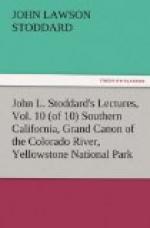SOUTHERN CALIFORNIA
[Illustration]
Nature has carefully guarded Southern California. Ten thousand miles of ocean roll between her western boundary and the nearest continent; while eastward, her divinity is hedged by dreary deserts that forbid approach. Although the arid plains of eastern Arizona are frequently called deserts, it is not till the west-bound tourist has passed Flagstaff that the word acquires a real and terrible significance. Then, during almost an entire day he journeys through a region which, while it fascinates, inspires him with dread. Occasionally a flock of goats suggests the possibility of sustaining life here, but sometimes for a distance of fifty miles he may see neither man nor beast. The villages, if such they can be called, are merely clusters of rude huts dotting an area of rocky desolation. No trees are visible. No grazing-ground relieves the dismal monochrome of sand. The mountains stand forth dreary, gaunt, and naked. In one locality the train runs through a series of gorges the sides of which are covered with disintegrated rock, heaped up in infinite confusion, as if an awful ague-fit had seized the hills, and shaken them until their ledges had been broken into a million boulders. At another point, emerging from a maze of mountains, the locomotive shoots into a plain, forty or fifty miles square, and sentineled on every side by savage peaks. Once, doubtless, an enormous lake was held encompassed by these giants; but, taking advantage of some seismic agitation, it finally slipped through their fingers to the sea, and now men travel over its deserted bed. Sometimes these monsters seemed to be closing in upon us, as if to thwart our exit and crush us in their stony arms; but the resistless steed that bore us onward, though quivering and panting with the effort, always contrived to find the narrow opening toward liberty. Occasionally our route lay through enormous fields of cactus and yucca trees, twelve feet in height, and, usually, so hideous from their distorted shapes and prickly spikes, that I could understand the proverb, “Even the Devil cannot eat a cactus.”
[Illustration: Life on the desert.]
[Illustration: The desert’s mountains.]
[Illustration: Desert vegetation.]
As the day wore on, and we were drawn from one scene of desolation to another, I almost doubted, like Bunyan’s Pilgrim, whether we should ever reach the promised land alive; but, finally, through a last upheaval of defiant hills which were, if possible, more desolate and weird than any we had seen, we gained the boundary of California and gazed upon the Colorado River. It is a stream whose history thrilled me as I remembered how in its long and tortuous course of more than a thousand miles to this point it had laboriously cut its way through countless desert canons, and I felt glad to see it here at last, sweeping along in tranquil majesty as if aware that all its struggles were now ended, and peace and victory had been secured.




